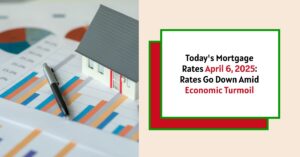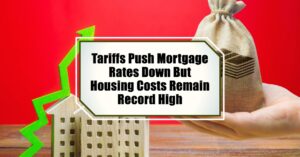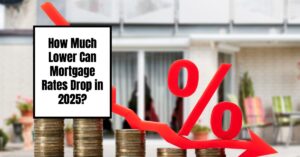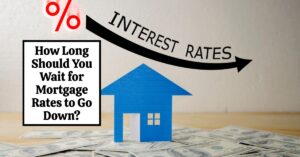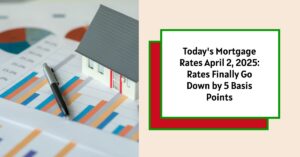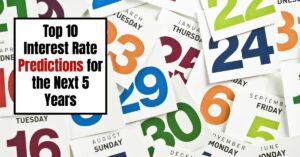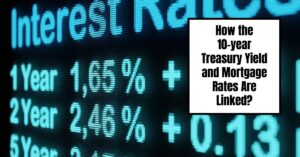As of April 6, 2025, mortgage rates have dropped significantly, reflecting changes in the economy. According to Zillow, the average 30-year fixed mortgage rate has decreased to 6.39%, while the 15-year fixed rate is now at 5.72%. These adjustments in rates indicate a response to economic pressures, including recently imposed tariffs that have raised concerns about inflation and economic growth. With lower rates available, it’s an essential time for buyers and current homeowners looking to refinance to understand these changes.
Today's Mortgage Rates April 6, 2025: Rates Go Down Amid Tariff Turmoil
Key Takeaways
- Mortgage Rates Decrease: Average 30-year fixed rate is now 6.39%, down from previous levels.
- Refinance Rates Drop: Average refinance rate for a 30-year mortgage is 6.43%.
- Impact of Tariffs: Economic strain from tariffs has triggered lower rates, affecting both purchases and refinances.
- Consider Preapproval: With rates falling, now may be an ideal time to get preapproved for a mortgage.
Current Mortgage Rates
Understanding the current mortgage rates is crucial for potential homebuyers and those looking to refinance. Here’s a summary of today’s average rates based on the latest data from Zillow:
Mortgage Rates
| Type of Mortgage | Interest Rate (%) |
|---|---|
| 30-Year Fixed | 6.39 |
| 20-Year Fixed | 6.01 |
| 15-Year Fixed | 5.72 |
| 5/1 Adjustable Rate | 6.48 |
| 7/1 Adjustable Rate | 6.42 |
| 30-Year VA | 5.91 |
| 15-Year VA | 5.54 |
| 5/1 VA | 5.93 |
| 30-Year FHA | 5.95 |
| 5/1 FHA | 5.69 |
Mortgage Refinance Rates
| Type of Refinance | Interest Rate (%) |
|---|---|
| 30-Year Fixed | 6.43 |
| 20-Year Fixed | 6.09 |
| 15-Year Fixed | 5.79 |
| 5/1 Adjustable Rate | 6.72 |
| 7/1 Adjustable Rate | 6.68 |
| 30-Year VA | 5.99 |
| 15-Year VA | 5.83 |
| 5/1 VA | 5.94 |
| 30-Year FHA | 6.05 |
| 15-Year FHA | 5.62 |
| 5/1 FHA | 5.63 |
These rates provide a snapshot of the national averages available. It’s important to note that specific lender rates may vary based on individual qualifications and market conditions.
Understanding Rate Drops
Mortgage rates have historically fluctuated based on various economic factors. The recent drop in rates is closely related to concerns surrounding tariffs. In comments made by Federal Reserve Chair Jerome Powell, he highlighted specific worries that tariffs might contribute to inflation while potentially slowing economic growth. The relationship between these tariffs and investor sentiment has led to lower yields on U.S. Treasury bonds, which are a crucial factor influencing mortgage rates.
When economic stability is threatened by external forces, such as trade disputes, the resulting uncertainty can drive investors to seek refuge in safer investments, such as Treasury bonds. If demand for these bonds increases, their yields decrease, and consequently, mortgage rates often follow suit. This allows borrowers to benefit from lower rates, making home purchases more affordable during uncertain economic times.
Fixed-Rate vs. Adjustable-Rate Mortgages
When considering which type of mortgage to choose, understanding the difference between fixed-rate and adjustable-rate mortgages (ARMs) is crucial. Fixed-rate mortgages maintain the same interest rate throughout the loan term, providing predictability in monthly payments. Currently, the average rate for a 30-year fixed mortgage stands at 6.39%, while the 15-year fixed is at 5.72%.
Here’s a more detailed look into both options:
- Fixed-Rate Mortgages:
These loans offer stability and predictability. Your monthly payment won’t change regardless of what happens in the wider economy. This is particularly advantageous in a financial landscape characterized by volatility. For instance, if you lock in a fixed rate, you won't be impacted by future rate hikes which can occur due to inflation or economic rebound. - Adjustable-Rate Mortgages (ARMs):
ARMs feature a fixed rate for a predetermined period, after which your rate adjusts based on the market. For example, a 7/1 ARM offers a fixed rate for the initial seven years before adjusting annually. The current ARM rates are slightly higher, with the 7/1 ARM at 6.42%. For some borrowers, especially those who plan to move or refinance before the rate adjustment, an ARM may seem appealing due to its initially lower rates.
Recommended Read:
Mortgage Rates Likely to Go Down in the Short Term Due to Tariffs
Mortgage Rates Trends as of April 5, 2025
Tariffs Push Mortgage Rates Down But Housing Costs Remain Record High
Mortgage Cost Comparison
Understanding what your monthly payment will look like is crucial, whether you choose a fixed or adjustable mortgage. Here’s a comprehensive comparison of costs based on obtaining a $300,000 mortgage.
- With a 30-Year Fixed Rate at 6.39%:
- Monthly Payment: Approximately $1,875
- Total Interest Paid over 30 Years: Roughly $374,839
- With a 15-Year Fixed Rate at 5.72%:
- Monthly Payment: Approximately $2,486
- Total Interest Paid: Roughly $147,554
Comparing these figures highlights the long-term savings connected to choosing a shorter term, despite the higher monthly payments. Opting for a fixed 15-year mortgage may mean you pay less in interest over the life of the loan compared to a 30-year option, making it an appealing choice for those who can manage the higher payments.
The Current Economic Climate and Its Impact on Mortgages
As we analyze today’s mortgage trends, understanding the larger economic environment is vital. Recently, economic indicators have shown a mix of strength and uncertainty. On one hand, job growth has reflected positively in the labor market, with March 2025 showing more jobs added than expected. However, on the other, the potential negative implications of trade disputes have raised red flags about long-term economic stability. Tariffs on goods can lead to increased costs for consumers and businesses, creating inflationary pressures that could adversely affect the broader economy.
Because of this economic backdrop, mortgage rates are quite unpredictable. Here are some factors that continue to influence rates:
- Federal Reserve Decisions: The Fed plays a crucial role in determining monetary policy and directly influences rates through its decisions regarding inflation and economic growth. If inflation rises due to tariffs, the Fed may have to raise interest rates, which could subsequently increase mortgage rates.
- Market Sentiment and Investor Behavior: The uncertain nature of global trade can lead to fluctuations in market confidence. When investors feel uneasy about economic prospects, they may shift investments into safer assets, again influencing mortgage rates.
- Overall Housing Demand: Trends in supply and demand within the housing market also play a role. Even with lower rates, if the market is saturated or there is insufficient demand, rates may not decrease as much as they could.
How to Secure the Best Rates
While many factors affect mortgage rates, individuals can take steps to secure better rates based on their financial profiles. Mortgage lenders are likely to offer the most competitive rates to those with:
- High Credit Scores: Individuals with higher credit scores are often seen as lower-risk borrowers. Lenders reward this by offering lower interest rates as companies are more inclined to lend to borrowers who show financial responsibility.
- Larger Down Payments: Offering a substantial down payment can lead to improved loan terms and lower rates. A higher down payment reduces the lender’s risk and may also eliminate the need for private mortgage insurance (PMI).
- Low Debt-to-Income Ratios: A lower debt-to-income ratio indicates financial stability. Borrowers with manageable debt relative to their income are more likely to qualify for advantageous rates.
The Importance of Pre-Approval
Given the current rate drop, securing pre-approval from lenders has become an attractive option for both potential buyers and those looking to refinance. A pre-approval not only provides a clearer picture of the mortgage amount you may qualify for but also positions you as a serious buyer in a competitive market. Many sellers prefer buyers who have been pre-approved, as it signals financial readiness and a commitment to the buying process.
Market Predictions and Future Outlook
Looking ahead, many wonder if mortgage rates will continue their downward trend or stabilize. Current predictions suggest that rates may remain low in the short term, heavily influenced by ongoing economic discussions surrounding tariffs and inflation. These tariffs may lead to rising prices, compelling the Federal Reserve to carefully evaluate its next moves.
Here are some future considerations to keep in mind regarding mortgage rates:
- Trade Relations and Economic Responses: Continued tariffs could provoke retaliatory actions from other countries, impacting global trade dynamics and causing economic fluctuations. The uncertainty around these developments could influence mortgage rates.
- Inflation Trends: If inflation rises significantly, the Federal Reserve may take steps to raise interest rates to combat it. Anticipating these shifts allows buyers to time their mortgage applications accordingly.
- Consumer Demand in Housing Markets: As mortgage rates affect buying power, the demand for housing may shift. Lower rates can stimulate demand, while rising rates may cool it down.
Understanding these intricate dynamics helps potential homebuyers and owners plan more effectively in an ever-changing market landscape.
Summary:
With mortgage and refinance rates dropping on April 6, 2025, it’s an opportune moment for buyers and homeowners to consider their options. The current rates reflect broader economic uncertainty and market fluctuations influenced by tariffs. Understanding these elements can empower you to make informed decisions in the housing market.
Work With Norada, Your Trusted Source for
Real Estate Investment in the U.S.
Investing in turnkey real estate can help you secure consistent returns with fluctuating mortgage rates.
Expand your portfolio confidently, even in a shifting interest rate environment.
Speak with our expert investment counselors (No Obligation):
(800) 611-3060
Also Read:
- Will Mortgage Rates Go Down in 2025: Morgan Stanley's Forecast
- Expect High Mortgage Rates Until 2026: Fannie Mae's 2-Year Forecast
- Mortgage Rate Predictions 2025 from 4 Leading Housing Experts
- Mortgage Rates Forecast for the Next 3 Years: 2025 to 2027
- 30-Year Mortgage Rate Forecast for the Next 5 Years
- 15-Year Mortgage Rate Forecast for the Next 5 Years
- Why Are Mortgage Rates Going Up in 2025: Will Rates Drop?
- Why Are Mortgage Rates So High and Predictions for 2025
- Will Mortgage Rates Ever Be 3% Again in the Future?
- Mortgage Rates Predictions for Next 2 Years
- Mortgage Rate Predictions for Next 5 Years
- Mortgage Rate Predictions: Why 2% and 3% Rates are Out of Reach
- How Lower Mortgage Rates Can Save You Thousands?
- How to Get a Low Mortgage Interest Rate?
- Will Mortgage Rates Ever Be 4% Again?
